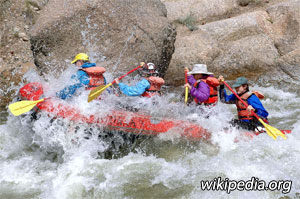
Many camping trips are planned around water activities — most of which are fairly tame in the wild adventure category. But whitewater rafting turns up the adventure needle up a couple notches for most campers, if they are willing to give it a try.
 Whitewater rafting has evolved into a safe activity for nearly all ages to enjoy, while still providing heart-pounding actions. Equipment used on whitewater today is safe and user friendly. Self-bailing rafts are safer and allow the rafter to focus on the ride and not bailing water from their craft.
Whitewater rafting has evolved into a safe activity for nearly all ages to enjoy, while still providing heart-pounding actions. Equipment used on whitewater today is safe and user friendly. Self-bailing rafts are safer and allow the rafter to focus on the ride and not bailing water from their craft.
These types of advancements in whitewater rafting have opened the door for a much more diverse participant base. Whitewater rafting outfitters must abide by state guidelines and industry standards, while adhering to a quality code of ethics. The selected outfitter will provide their specific guidelines and inform what is expected from you and how you should prepare. Your outfitter will inform you of exactly what you will need to bring and what they provide in the trip package.
Choose Your Level of Rapids
When you plan your trip in advance, you can plan on the level of excitement you are wanting. Whitewater is broken down into six class levels of rapids. Although weather impacts rafting trips just like any other outdoor activity, some river levels are controlled by man. Depending on the river's location and purpose, flow control is regulated by a government service, with the releases determined by the season. During the spring and fall, lake and reservoir water releases through their dams create a more aggressive ride.
Rapid Classes Descriptions
According to American Whitewater, below are the class descriptions:
|
Class I: Beginner Fast moving water with riffles and small waves. Few obstructions, all obvious and easily missed with little training. Risk to swimmers is slight; self-rescue is easy. |
|
Class II: Novice Straightforward rapids with wide, clear channels which are evident without scouting. Occasional maneuvering may be required, but rocks and medium-sized waves are easily missed by trained paddlers. Swimmers are seldom injured and group assistance, while helpful, is seldom needed. Rapids that are at the upper end of this difficulty range are designated "Class II+". |
|
Class III: Intermediate Rapids with moderate, irregular waves which may be difficult to avoid and which can swamp an open canoe. Complex maneuvers in fast current and good boat control in tight passages or around ledges are often required; large waves or strainers may be present but are easily avoided. Strong eddies and powerful current effects can be found, particularly on large-volume rivers. scouting is advisable for inexperienced parties. Injuries while swimming are rare; self-rescue is usually easy but group assistance may be required to avoid long swims. Rapids that are at the lower or upper end of this difficulty range are designated "Class III-" or "Class III+" respectively. |
|
Class IV: Advanced Intense, powerful but predictable rapids requiring precise boat handling in turbulent water. Depending on the character of the river, it may feature large, unavoidable waves and holes or constricted passages demanding fast maneuvers under pressure. A fast, reliable eddy turn may be needed to initiate maneuvers, scout rapids, or rest. Rapids may require “must” moves above dangerous hazards. Scouting may be necessary the first time down. Risk of injury to swimmers is moderate to high, and water conditions may make self-rescue difficult. Group assistance for rescue is often essential but requires practiced skills. A strong eskimo roll is highly recommended. Rapids that are at the lower or upper end of this difficulty range are designated "Class IV-" or "Class IV+" respectively. |
|
Class V: Expert Extremely long, obstructed, or very violent rapids which expose a paddler to added risk. Drops may contain large, unavoidable waves and holes or steep, congested chutes with complex, demanding routes. Rapids may continue for long distances between pools, demanding a high level of fitness. What eddies exist may be small, turbulent, or difficult to reach. At the high end of the scale, several of these factors may be combined. Scouting is recommended but may be difficult. Swims are dangerous, and rescue is often difficult even for experts. A very reliable eskimo roll, proper equipment, extensive experience, and practiced rescue skills are essential. Because of the large range of difficulty that exists beyond Class IV, Class 5 is an open-ended, multiple-level scale designated by class 5.0, 5.1, 5.2, etc., each of these levels is an order of magnitude more difficult than the last. Example: increasing difficulty from Class 5.0 to Class 5.1 is a similar order of magnitude as increasing from Class IV to Class 5.0. |
|
Class VI - Extreme and Exploratory Rapids These runs have almost never been attempted and often exemplify the extremes of difficulty, unpredictability and danger. The consequences of errors are very severe and rescue may be impossible. For teams of experts only, at favorable water levels, after close personal inspection and taking all precautions. After a Class VI rapids has been run many times, its rating may be changed to an apppropriate Class 5.x rating. |
- 2315 views

